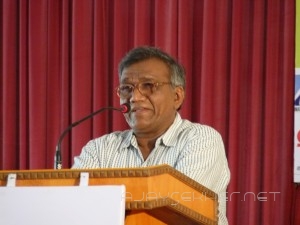by Chandrabhan Prasad
About a decade back, Rajasthan’s Nathdwara town was in the news. The town houses a Hindu temple into which Dalits are not allowed. The maverick Arya Samaj sadhu Swamy Agnivesh had organised a march to accord Dalits their right to enter the temple. Read More Most newspapers wrote lengthy editorials condemning the priests of Nathdwara. Nathdwara-type situations persist in most parts of India but only when such incidents come into the limelight, does the Varna media launch a spirited condemnation.
Dalits have, since the time of Sant Ravidas, argued that untouchability is only the symptom and not the disease. The disease is the Chatur-Varna “doctrine of exclusion” which most Varna members practice, only its form changes in changed contexts. For instance, the Indian Express editor, or the editors of most other dailies, will not organise armed bands to deal with Dalit writers. They will simply look at an article authored by a Dalit, tear the pages and throw them into the dustbin.
A Rajput principal of some Delhi University (DU) college will not behave the way his brethren in Aligarh or Fatehpur do. This principal lives in a different context, where violent methods are neither feasible, nor desired. He will simply misplace Dalit application forms, or manipulate the rules to deny Dalits their right of admission. A University Vice-Chancellor will not behave like the Nathdwara priests. He will not put up a board, at Mall road, refusing Dalits entry into the University campus. He, when it is time to choose lecturers, will constitute an interviewing board of experts who, in turn, will pronounce Dalits unfit for teaching jobs. A Varna candidate, instead, will be appointed.
But the intelligentsia and media maintain a thundering silence over such discrimination. To them, caste discrimination relates only to the practice of untouchability and brute forms of violence against Dalits. Barring The Pioneer, no major newspaper or TV channel rushed to DU in order to investigate why the University employed only one Dalit teacher out of every 100, against the constitutionally mandated 22.5 per cent? If DU, which is only miles away from Indian Parliament, can trample all over the Constitution, then how do we corner the priests of Nathdwara or the Ranvir Sena of Bihar? Encouraged by the intelligentsia/media’s unstated solidarity, the academic mafia of Delhi University has turned into a rouge organisation, putting even J Jayalalitha to shame.
I have come across a bizarre case of discrimination brought about by the Department of Commerce, Delhi School of Economics, DU. Thus goes the story of Dhani Ram, who has done his MCom from Shri Ram College of Commerce. Ram comes from a sleepy village in Aligarh district, UP. According to the dossier prepared by him, both his parents are illiterate and earn their livelihood by working as farm labour. Defying his poverty, he finished school. But even as a student, he worked as a labourer and pitched in towards the family’s income. He passed his Plus-2 examination with a second division and was encouraged by relatives to study further.
Ram enrolled himself with Agra University and passed his BCom with a first division, getting as much as 96 per cent in the cost accountancy examination. His relatives collected the necessary money and sent him to Delhi. Defying the language barrier (he had to switch over to English), he passed his MCom with a second division, getting 85 per cent in management accountancy. He soon became a well known face in the University’s commerce department. The academic mafia, however, feared that if Ram were allowed to enroll for an M Phil or a PhD, he would be tempted to claim a Lectureship position with the University. Which is where the plot begins.
Ram did apply to an MPhil course, but was denied admission. Eighty candidates were declared eligible to sit for the entrance test, of which 19 were short listed for the interview. There were no Dalits. Ram pursued the matter and ultimately, three Dalits were called for the interview. When the final list was released, 15 candidates were offered admission. Two Dalits figured in the list but Ram’s name was omitted. Surprisingly, according to Ram’s 104-page dossier, a Dalit candidate, with lower marks at both the BCom and MCom level and who had not qualified for the interview, was later called for another interview. He was selected. As per reservation rules, there should have been three Dalits.
Both the Dalits who had been selected wrote letters of protest and argued that Ram be accommodated. But, a few faculty members took special interest in the two protesting Dalits, promised them the earth and got them to deposit their fees. Ram has approached the concerned authorities, but has failed to get himself admitted. Meanwhile, one of the Dalit students who had joined up, has not attended a single class since the last academic session. This is how a bright Dalit is being discriminated and denied the opportunity to higher education. Hasn’t Delhi University turned into another Nathdwara?








